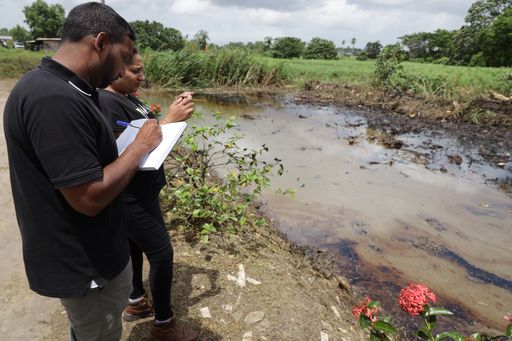(Trinidad Guardian) Residents of Katwaroo Trace, Penal, are facing a new threat, as oil-slicked snakes are now invading their properties in the aftermath of Monday’s oil spill.
Clean-up crews contracted by Heritage Petroleum have been diligently working to remove the thick vegetation from the contaminated lagoons, but residents are now worried with the emergence of these reptiles.
Speaking to Guardian Media yesterday, resident Sheriza Manoo admitted to killing over 15 snakes to protect her young children. Some of the snakes were venomous, brown-banded water mapepires.
Saying while they no longer had respiratory concerns now that the strong hydrocarbon scent had dissipated, Manoo said the snakes now posed a more serious problem for residents.
“Last night, one snake dropped from the roof. It was black and my dad had to kill it,” she said.
Between Thursday night and yesterday morning, Manoo said they had eliminated 15 snakes due to the hazards they posed to the safety of their family, especially the children.
She added, “This morning I had to run down a squirrel which was also covered in oil. It is sad.”
When Guardian Media arrived on the scene, wildlife handlers from Serpentarium, which is based in El Socorro, San Juan, along with game wardens Sheetal Ramsaran and Stephon Ramoutar, from the Forestry Division, were present to assist with animal rescues.
Aziz Khan, another concerned resident, said he was disheartened to see birds covered in oil. Recalling his routine of feeding blue water hens in his backyard, he called upon the Environmental Management Authority (EMA) to urgently investigate the matter, emphasising the need to safeguard the environment and its robust ecosystem.
Aleem Khan, who is coping with a broken leg, expressed the risks posed by the invading snakes to the villagers.
“It’s not nice to know snakes are coming into the property, especially when I am like this,” he said while pointing to his cast.
Meanwhile, Minister of Agriculture Kazim Hosein yesterday told Guardian Media that approximately 20 acres of marshlands were affected by the oil spill. He revealed that several wildlife species, including brown-banded water snakes, red-sided water snakes, caimans, and river turtles, had been successfully rescued and rehabilitated. Wild ducks, capybaras, mongoose and herons, he said, were fortunate enough to avoid severe impacts and have since left the affected areas.
Minister Hosein commended all the teams involved in caring for the wildlife, stating, “The response and subsequent clean-up exercises of this oil spill have been incident-free, thanks to the professionalism and dedication of our game wardens and the cooperation extended by all involved parties.”
In a statement, the EMA said their Emergency Response and Investigations Unit, in coordination with the Ministry of Energy and Energy Industries, conducted a joint agency site visit yesterday. The EMA confirmed the identification and clamping of the source of the spill. They said initial clean-up efforts faced challenges due to flooding, but EMA officers will continue to monitor the area to ensure no further environmental impact occurs.
The recent oil spill at Katwaroo Trace and Ramdharry Trace on Clarke Road, Penal, marks the third major spill this year caused by ruptures from Heritage Petroleum’s ageing pipelines. The first occurred in Guayaguayare in February, followed by a rupture at Massahood Junction, Fyzabad, in May.






